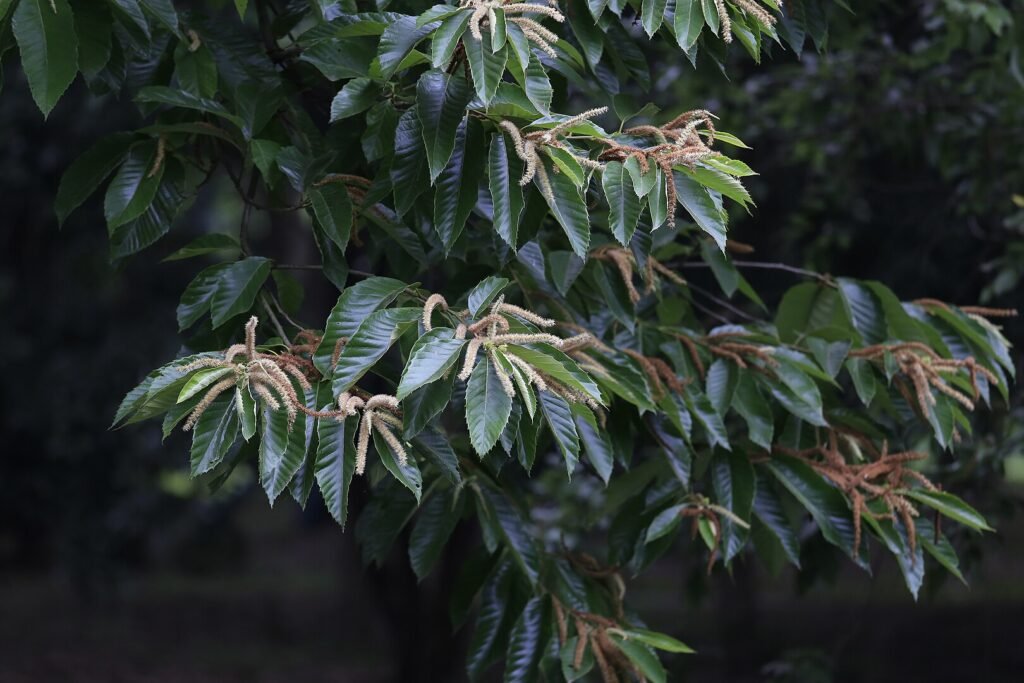Do you want to produce an abundance of delicious, hearty nuts in your forest garden? If so, the Chinese chestnut will be the star of your garden! Read on to find out everything you need to know about this valuable forest garden species.
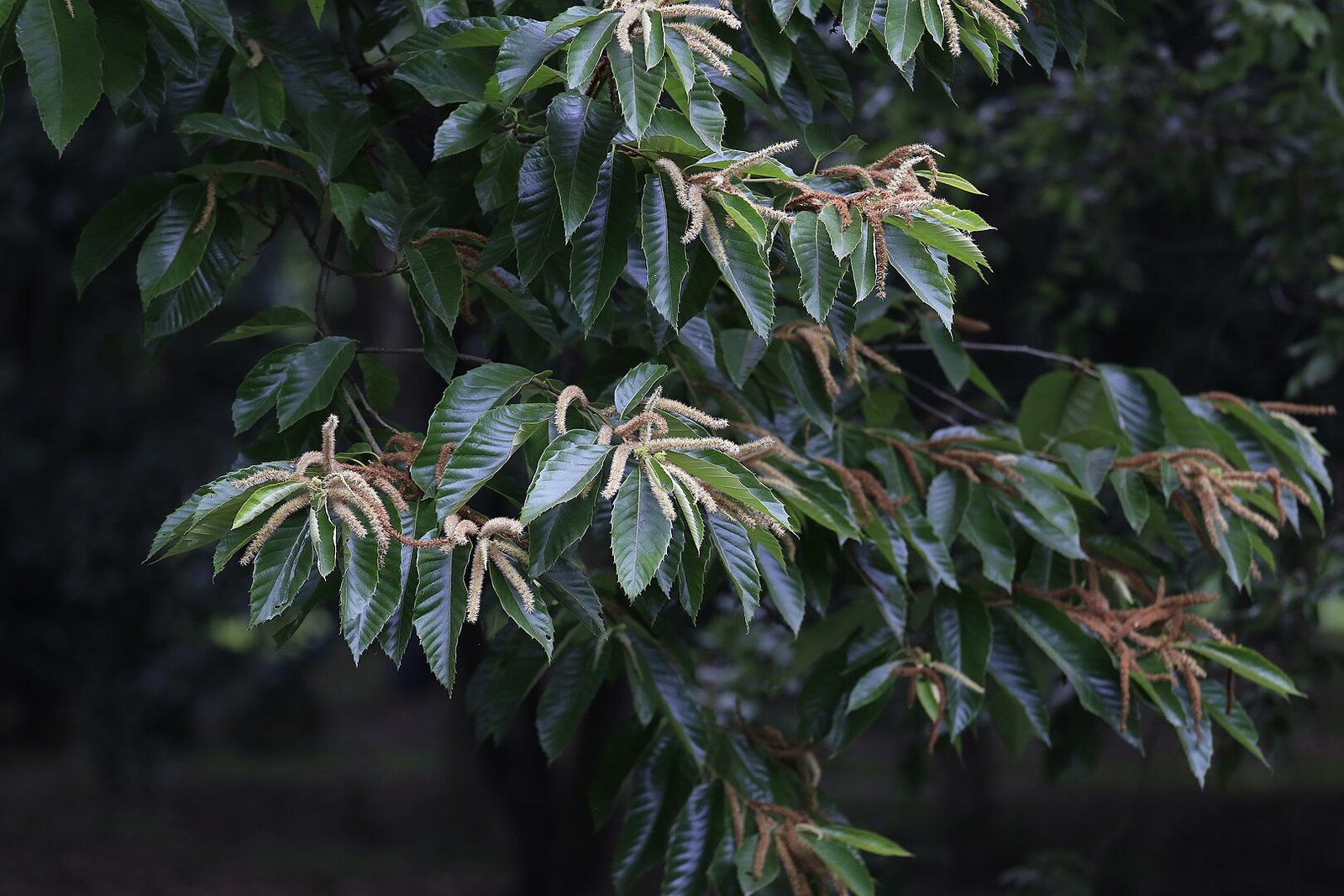
Chinese Chestnut: The Star of Edible Agroforestry
- Quick Facts About the Chinese Chestnut
- Introduction
- Plant Selection
- Site Selection and Planning
- Planting
- Harvesting
- Recipes
- FAQ
- How fast do Chinese chestnut trees grow?
- What is the difference between Chinese chestnut vs. American chestnut?
- How long until my Chinese chestnut produces?
- How much can a Chinese chestnut produce annually?
- How long do Chinese chestnuts live?
- How far apart should I plant Chinese chestnut trees?
- Do I need to plant more than one Chinese chestnut?
Quick Facts About the Chinese Chestnut
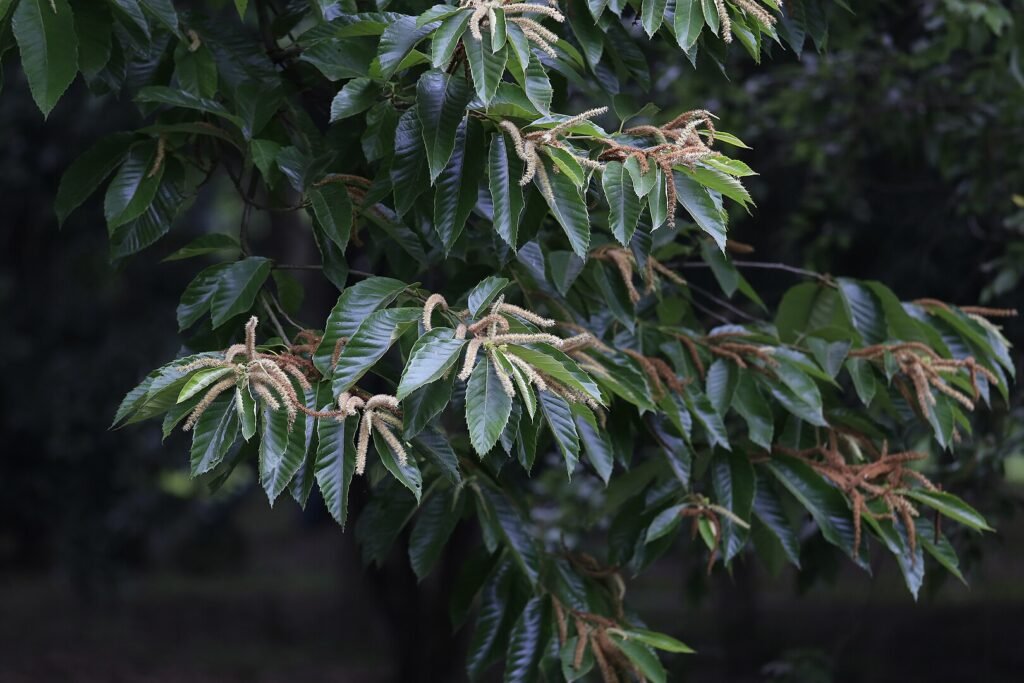
| Common Name | Chinese chestnut |
| Scientific Name | Castanea mollissima |
| Family | Fagaceae |
| Hardiness Zones | Zones 5 to 8 |
| Light | Full-Sun |
| Water | Drought tolerant, well-drained soils. Should not be planted in poorly-drained areas or soils with a high water table due to prevalence of Phytophthora root rot. Water during establishment. |
| Soil | Well-drained, sandy or loamy soils. pH from 5.5 to 6.5 |
| Size | Height: 25-40 feet, Width: 25-35 feet |
| Forest Garden Layer | Tall Tree Layer, Low Tree Layer |
| Edible Uses | Highly Nutritious Nuts |
| Ecosystem Services | Pollinator, Coppice Species |
| Pests | Chestnut Weevil, Yellow Neck Caterpillar, Potato Leafhopper, Oriental Chestnut Gull Wasp. Deer and small mammals may browse young trees. |
| Diseases | Phytophthora root rot. Resistant to Chestnut Blight (Cryphonectria parasitica). |
Introduction
History
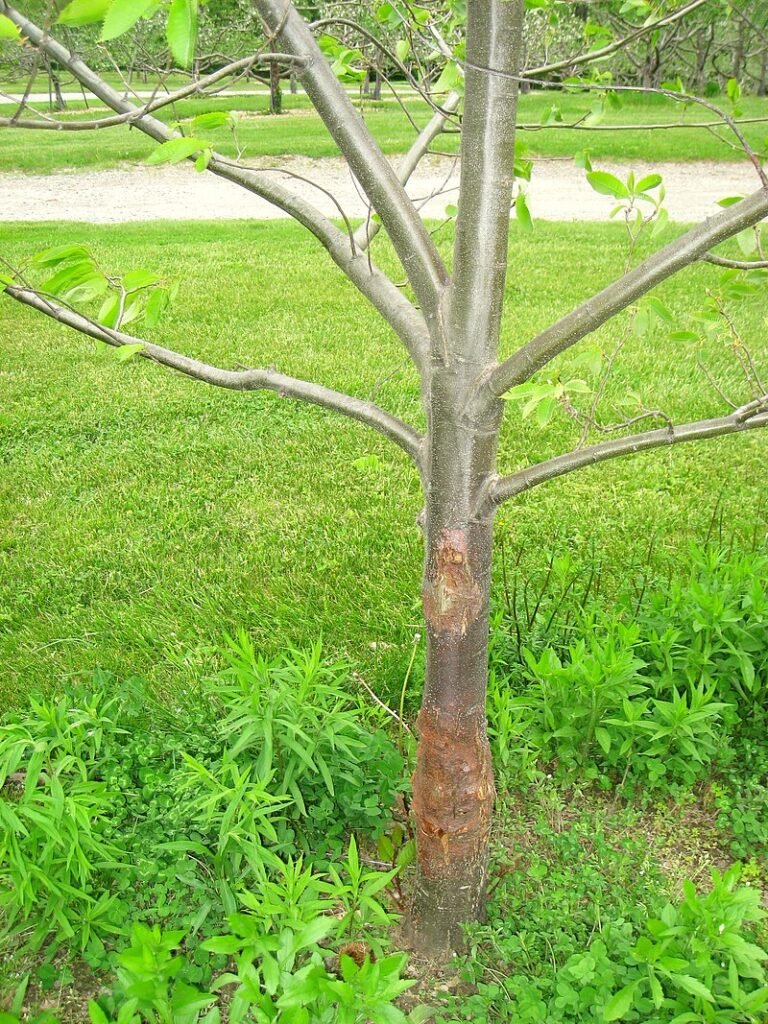
Chestnuts have been a staple food crop for human societies across the Northern Hemisphere for millennia. The earliest evidence of their use even predates the cultivation of our major cereal crops!
There are several major chestnut species within the genus Castanea – the American chestnut (C. dentata), Chinese chestnut (C. mollissima), European chestnut (C. sativa), Japanese chestnut (C. crenata). This genus also includes the chinquapins, or dwarf chestnuts.
Prior to the 20th century, American chestnut was prized in North America as a food and timber crop. In some areas of the Appalachian Mountains, one quarter of all hardwoods were estimated to be chestnuts! But in the first half of the 20th century, chestnut blight (Cryphonectria parasitica), a fungal disease, spread through the American chestnut population, killing between 3 and 4 billion trees.
The Chinese chestnut has gained prominence in North America in recent years due to its resistance to blight. Growers are making to hybridize different chestnut species in order to produce blight resistant varieties and reintroduce chestnut stands to North America.
Why We Love Chinese Chestnuts
Aside from their blight-resistance, Chinese chestnut varieties are a fantastic addition to any forest garden or agroforestry operation for their hardiness, low-maintenance, and many practical uses.
Chestnut trees are also exceptionally hardy, growing in soils that are too sandy or acidic for many others species. Once established, chestnuts also resist drought well. This resilience has contributed to their historic use as a primary carbohydrate source in mountainous and forest-dwelling communities with poor access to wheat flour.
Because of their hardiness, Chinese chestnuts require relatively little maintenance. You can prune trees in the years after establishment to achieve ideal crown shape. Spraying may be indicated for specific pests – leafhoppers, spider mites, or yellow necked caterpillars – but should rarely be necessary. Once they have reached bearing age, the main work to maintain your chestnuts will be harvesting, which can yield over 100 pounds of chestnuts per tree, once mature!
Although prized for their delicious nuts – which can be roasted, candied, or ground into flour to make bread or cake – chestnuts have a variety of other beneficial uses. Nuts and leaves make good fodder for animals, making chestnuts stands a useful crop for silvopasture operations. Trees can be coppiced on a 10-12 year cycle, creating timber for firewood or fenceposts. Wildlife also prize chestnut trees as a food and habitat source.
Plant Selection
When selecting your chestnut trees, it is important to select for blight-resistance. Chinese chestnut species are ideal for this, though certain varieties are more resistant than others. Growers have also bred certain hybrid varieties for blight-resistance. Work with your nursery to find the best stock available!
It is also important to plant more than one chestnut cultivar. Chestnuts are considered self-sterile – they will not self-pollinate or pollinate trees which have come from the same grafting stock. Again, working with your nursery will help ensure you get make the best selection to achieve the yields you hope for!
Site Selection and Planning

To ensure the success of your Chinese chestnut trees, it is important to select an appropriate site for their growth. Keep the following conditions in mind:
- Soil: Chestnuts should be planted in well-drained, sandy to loamy soil. Obviously, the more fertile your soil, the better, but Chinese chestnut can still grow well in dry, rocky soils. The preferred pH range is from 5.5-6.0, though trees will tolerate up to a pH of around 7.0.
- Temperature: Trees are hardy to around -20° F, or USDA Zone 5, and produce better when subjected to chill temperatures during winter dormancy.
- Water: Optimum rainfall for chestnuts is 31 inches per year, with even distribution of waterings. Once established, chestnuts are drought-tolerant, but young trees should be watered during dry spells to ensure healthy establishment.
- Sunlight: Chestnuts should be planted in full sunlight.
- Spacing: At full maturity, Chinese chestnuts should be planted roughly 35-40 feet from each other in order to maintain full sun exposure. When establishing chestnuts, it is possible to space them as close as 20 feet apart with the understanding that trees will need to be selectively thinned as they mature.
Planting
Basics
When you purchase your trees, they will either come with bare roots or in a large container. You should plant bare root trees as soon as possible, keeping the roots kept moist until you can get them in the ground. You do no have to plant container grown trees immediately, but do not leave chestnut trees to grow in a container, as they will quickly become root-bound.
It is best to plant Chinese chestnuts in the fall, before the ground has begun to freeze. It is also possible to plant in early spring, after the ground has thawed.
Planting Procedure
- For container grown chestnuts – remove the chestnut from the container and clear as much soil from the root structure as possible. You can set the container soil aside to backfill the hole later. This step allows you to spread the roots out effectively when you put the tree in the ground, alleviating any root binding that may have begun to occur in the container.
- While you work, keep your plant roots moist by setting them in a bucket or tote full of water, or by wrapping roots in damp newspaper.
- Find the tree’s groundline – the sharp color transition on the trunk where the soil was leveled against the seedling as it grew in the nursery. It is important for setting the planting depth.
- Dig your hole. The hole should be wide enough that roots can be spread out without crowding and deep enough that the tree’s groundline sits 1-2 inches above the final grade after mulching (less for small trees, more for larger ones).
- Score the sides of the hole with your shovel. Digging will compact the sides of your hole. Breaking them up will help the trees roots to expand past the hole’s limits as they grow.
- Lay your tree roots out in the hole, making sure they are not tangled. Particularly long roots can be trimmed, but this should be avoided if possible.
- Backfill your hole, using the soil you removed earlier. Be sure to break up the soil as you go, making sure there are no large air gaps between clumps, which can prevent roots from growing healthily. You can use soil from nursery containers to supplement the backfill material.
- Water the plant in and gently compress the soil. This helps to remove air gaps, giving roots a loose, but consolidated soil matrix to grow through. Don’t compress the soil too hard – this step is to remove air pockets, not to create compaction!
- Mulch around the tree. Mulch could be straw, leaf mulch, or wood chips. Apply mulch in an even layer around the tree to keep weeds to a minimum and help retain soil moisture. Avoid “volcano mulching” or piling mulch in a cone directly against the tree – remember you want the tree’s groundline to stand proud about 1-2 inches above the final grade.
- Tree tubes can be used to protect seedlings from wind and browsing critters as they get established. They also encourage straight, vertical growth, and create a hospitable microclimate for the tree.
Harvesting
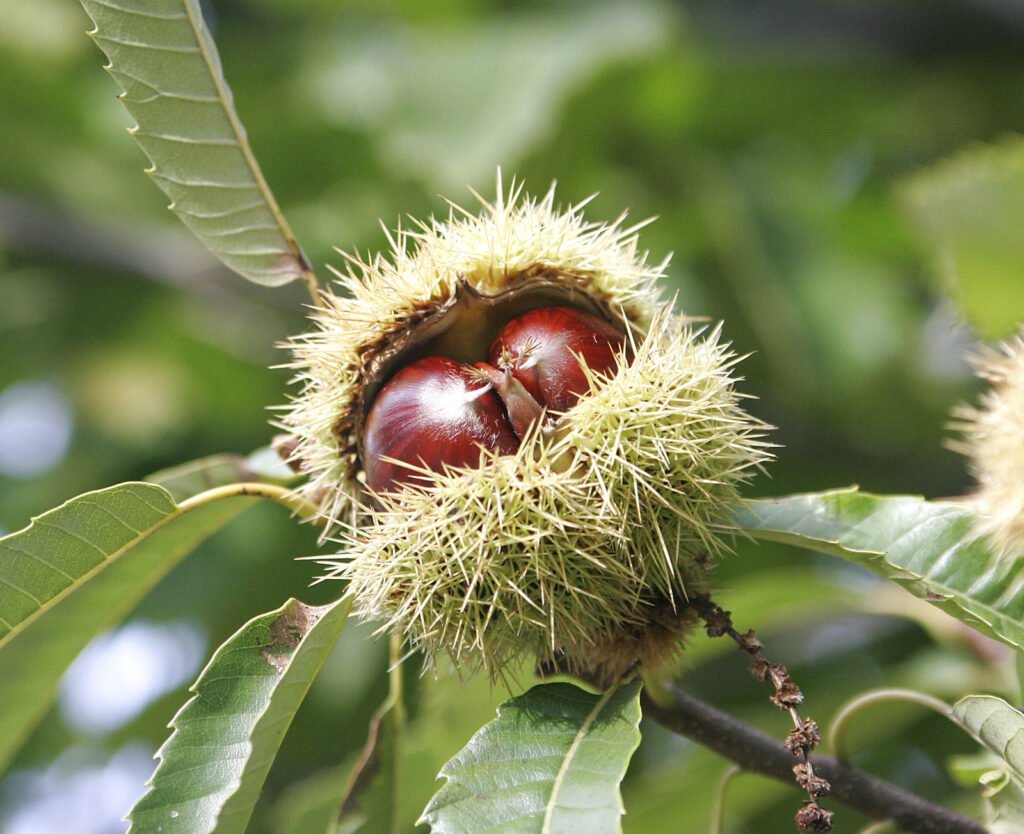
Chestnut harvest typically occurs from September through October, with trees dropping nuts for 2-4 weeks. You should gather nuts quickly after they have fallen to preserve freshness and to keep wildlife from eating your harvest.
Small forest gardens can easily harvest chestnuts by hand. You can simply pick up mature pods from the ground and collect them in a bucket. Chestnut pods have sharp burrs, so wear tough gloves while doing this!
If you’d like to speed up your hand harvesting, tools such as a Nut Wizard can also be helpful! The Nut Wizard is a rolling mesh cage which will pick up nuts for you without all the bending over!
Recipes
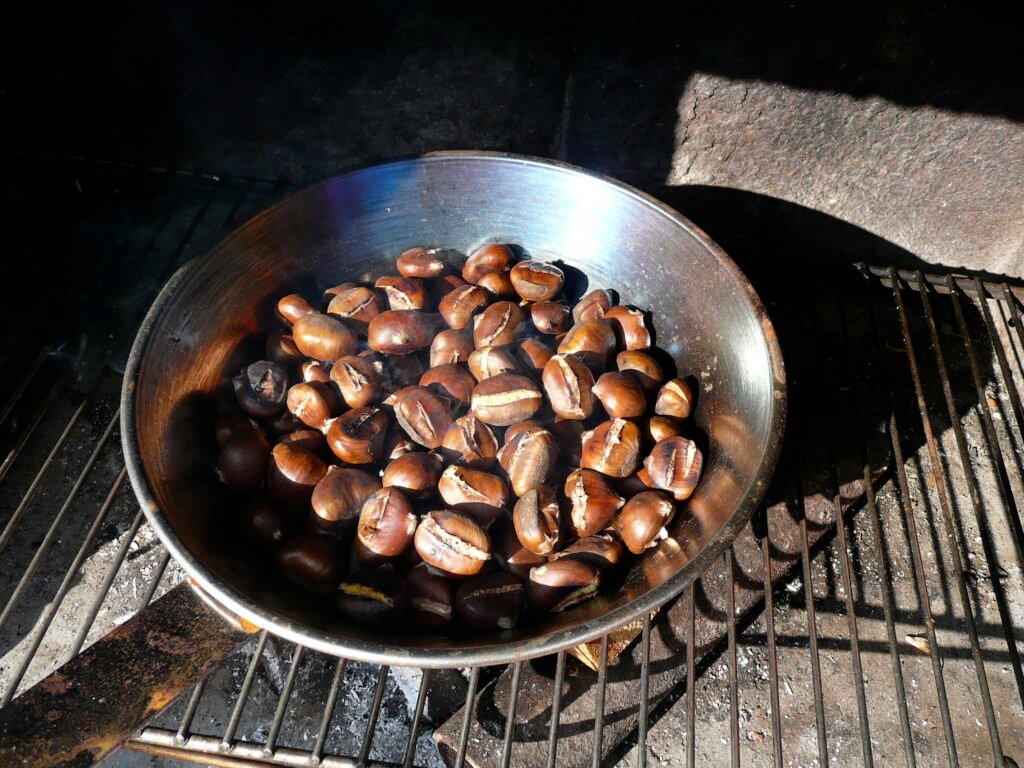
If you are looking for ideas for how to use your chestnut harvest, take a look at some of our favorite recipes!
- Roasted Chestnuts (from Tastes Better From Scratch) – this classic chestnut preparation brings out the best of the chestnut flavor, and makes them significantly easier to peel!
- Marrons Glacés (from Caroline’s Cooking) – a traditional candied chestnut, popular throughout Europe, is a great variation for those of you with a sweet tooth!
- Castagnaccio or Chestnut Flour Cake (from The Plant Based School) – although often eaten whole, chestnuts can also be ground into a flour to be used in baking. Try this delicious chestnut flour cake from Italy!
FAQ
This article has been an introduction to the history and uses of the Chinese chestnut tree. If you would like to learn more about Chinese chestnut trees or how you can start using them in your forest garden, let us know in the comments or send us an e-mail. Happy gardening!

